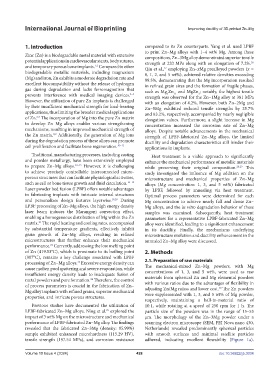Page 436 - IJB-10-4
P. 436
International Journal of Bioprinting Improving ductility of 3D-printed Zn–Mg
1. Introduction compared to its Zn counterparts. Yang et al. used LPBF
to print Zn–Mg alloys with 1–4 wt% Mg. Among these
Zinc (Zn) is a biodegradable metal material with extensive compositions, Zn–3Mg alloy demonstrated superior tensile
potential applications in cardiovascular stents, body sutures, strength at 220 MPa along with an elongation of 7.2%.
26
and temporary porous bone implants. Compared to other Qin et al., employing Zn–xMg prealloyed powders (x =
1,2
27
biodegradable metallic materials, including magnesium 0, 1, 2, and 5 wt%), achieved relative densities exceeding
(Mg) and iron, Zn exhibits a moderate degradation rate and 99.5%, demonstrating that the Mg incorporation resulted
excellent biocompatibility without the release of hydrogen in refined grain sizes and the formation of fragile phases,
gas during degradation and lacks ferromagnetism that such as Mg Zn and MgZn ; notably, the highest tensile
2
2
11
prevents interference with medical imaging devices. strength was observed for the Zn–1Mg alloy at 381 MPa
3–5
However, the utilization of pure Zn implants is challenged with an elongation of 4.2%. However, both Zn–2Mg and
by their insufficient mechanical strength for load-bearing Zn–5Mg exhibited reduced tensile strengths by 25.7%
applications, thus limiting the broader medical applications and 83.2%, respectively, accompanied by nearly negligible
of Zn. The incorporation of Mg into the pure Zn matrix elongation values. Furthermore, a slight increase in Mg
6,7
to develop Zn–Mg alloys enables various strengthening concentration increased the corrosion rate of Zn–Mg
mechanisms, resulting in improved mechanical strength of alloys. Despite notable advancements in the mechanical
the Zn matrix. Additionally, the generation of Mg ions strength of LPBF-fabricated Zn–Mg alloys, the limited
8,9
during the degradation process of these alloys can promote ductility and degradation characteristics still hinder their
cell proliferation and facilitate bone regeneration. 10–12 applications in implants.
Traditional manufacturing processes, including casting Heat treatment is a viable approach to significantly
and powder metallurgy, have been extensively employed enhance the mechanical performance of metallic materials
to prepare Zn–Mg alloys. 13–15 However, it is challenging while preserving their original composition. 28,29 This
to achieve precisely controllable interconnected micro- study investigated the influence of Mg addition on the
porous structures that can facilitate physiological activities, microstructure and mechanical properties of Zn–Mg
such as cell or bone tissue growth and fluid circulation. 16–18 alloys (Mg concentration: 1, 3, and 5 wt%) fabricated
Laser powder bed fusion (LPBF) offers notable advantages by LPBF, followed by annealing via heat treatment.
in fabricating implants with intricate internal structures Optimal process parameters were determined for each
and personalizes design features layerwise. 19,20 During Mg concentration to achieve nearly full and dense Zn–
LPBF processing of Zn–Mg alloys, the high energy density Mg alloys, and the in vitro degradation behavior of these
laser beam induces the Marangoni convection effect, samples was examined. Subsequently, heat treatment
enabling a homogeneous distribution of Mg within the Zn parameters for a representative LPBF-fabricated Zn–Mg
matrix. The rapid heating and cooling rates, accompanied alloy were identified, leading to a significant enhancement
21
by substantial temperature gradients, effectively inhibit in its ductility. Finally, the mechanisms underlying
grain growth of Zn–Mg alloys, resulting in refined microstructure evolution and ductility enhancement in the
microstructures that further enhance their mechanical annealed Zn–Mg alloy were discussed.
performance. Currently, addressing the low melting point
22
of Zn (419.53°C), which is proximate to its boiling point 2. Methods
(907°C), remains a key challenge associated with LPBF
processing of Zn–Mg alloys. Excessive energy density can 2.1. Preparation of raw materials
23
cause molten pool spattering and severe evaporation, while The mechanical-mixed Zn–Mg powders, with Mg
insufficient energy density leads to inadequate fusion of concentrations of 1, 3, and 5 wt%, were used as raw
metal powders and pore formation. Therefore, the control materials from spherical Zn and Mg elemental powders
24
of process parameters is crucial in the fabrication of Zn– with various ratios due to the advantages of flexibility in
adjusting Zn/Mg ratios and lower cost. The Zn powders
30
Mg alloy implants with refined grains, superior mechanical were supplemented with 1, 3, and 5 wt% of Mg powder,
properties, and intricate porous structures.
respectively, maintaining a ball-to-material ratio of
Previous studies have documented the utilization of 10:1, while rotating at a speed of 250 rpm for 1 h. The
25
LPBF-fabricated Zn–Mg alloys. Ning et al. explored the particle size of the powders was in the range of 15–53
impact of 3 wt% Mg on the microstructure and mechanical μm. The morphology of the Zn–3Mg powder under a
performance of LPBF-fabricated Zn–Mg alloy. The findings scanning electron microscope (SEM, FEI Nova nano 430,
revealed that the fabricated Zn–3Mg (density: 95.99%) Netherlands) revealed predominantly spherical particles
sample exhibited enhanced microhardness (115.29 HV), with smooth surfaces and minimal satellite particles
tensile strength (197.54 MPa), and corrosion resistance adhered, indicating excellent flowability (Figure 1a).
Volume 10 Issue 4 (2024) 428 doi: 10.36922/ijb.3034

